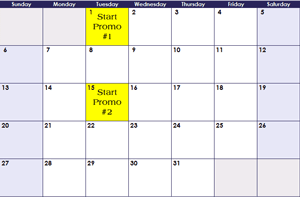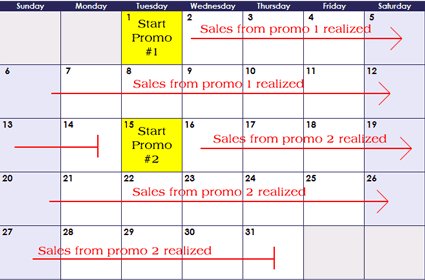 In my last article Planning Ecommerce Promotions I discussed some details on why you should take the time to carefully plan your promotions using a 12 month calendar as a guide.
In my last article Planning Ecommerce Promotions I discussed some details on why you should take the time to carefully plan your promotions using a 12 month calendar as a guide.
In this article I’ll briefly detail a starting point for timing of those promotions during a typical 4 week period.
Keep in mind that this should be a starting point for you to work with and grow from. Understanding when your customers buy the first time, their frequency of repeat orders, and your market itself should dictate what time periods you should zero in on for your store. You can get answers to these questions and more by reading your analytics.
If you recall, during my last article I said that I recommended planning out at least 2 different promotions (with room for a third) per month and as a starting point. Run those promotions (one at a time) during the first and third week of the month.
My logic behind this is that it enables your promotions to drive sales which are generally realized during the month the promotion is active. This can help you better forecast sales for a given month based on promotions and use those promotions to actually hit “quota targets” when needed.
Here’s why.
Running a promotion for a two week period starting week one enables you to realize sales generated from that promotion during both weeks one and two of the same month. Likewise, it stands to reason that running a promotion for the remaining two weeks of a month starting at week three would enable you to realize sales from that promotion during both weeks 3 and 4 of the month (keeping sales generally allocated to the month in which the promotion is run.)

The timing of when the sales are realized in the above example is again, a general theory of what you can expect. Depending on the promotion itself, and buyer latency, you may see these gains realized at various intervals.
Week Three – the “Quota Buster”
One more thing I like to do with this type of promotional setup is to make sure my week three promo is the one that has continually proven to generate some serious sales.
Once you have tested your market and determined a promotion or two that always generates interest and subsequently sales, save those promos for the third week. I use them in cases where we are close to a monthly revenue goal and activating one will likely get us there or push us over the top. That’s why I call it the “quota buster” promo.
The quota buster promo is one that your customers find “too good to pass up.” It’s one that they feel they must take advantage of because they may not see it again.
For example, if you typically offer a 10% promo and you can afford to (on occasion) give 40% off (again, this is for example sake), AND that promo generates some above average sales volumes, then the “40% promo” could be the quota buster. This does take careful planning as you want to make sure the promotion also gives you enough margin to put net revenue in your pocket as a result.
Unless you are looking to “break even” on the sale in order to gain repeat business from the customer in the near future, what good is a nice promotion if you don’t end up with net revenue from it? Plan your strategy according to your business objective.
Timing and planning promotions is one critical element toward driving business sales. Once fine tuned, this element of your business should be one you can count on to ensure your growth. Take them time to give your careful attention to it and you will be rewarded.
One of my clients is proposing a “summer sale” from August 1 – September 1. What are your thoughts on a promotion that runs for a full month ?
I’m all for promotions that run for a full month if they fit. In fact, I have and am running a number of “month long” promos with several store owners I coach.
I found through my testing that if you run the promo too long however, it can begin to “lose its value”.
The concepts laid out in this post aim to drive sales based on “urgency” (fairly limited time offers) and help store owners boost sales during a given 4 week window.